When visiting Bangkok, you should check out the Jim Thompson House. It’s a popular attraction that showcases traditional Thai art and architecture. You can immerse yourself in the local culture and appreciate what’s on display. The house used to belong to a former American CIA spy and businessman who loved Thailand. With his house, he wanted to preserve its heritage. He mysteriously disappeared in 1967 and left behind a legacy that people still find fascinating today.
Table of Contents
What to see at the Jim Thompson House
The Jim Thompson House is a house museum that showcases traditional Thai architecture with a modern twist. It was built by Jim Thompson in 1958, using six different Thai teakwood houses from the 19th century. Jim Thompson sourced the original houses from the ancient capital Ayutthaya and the Ban Krua community in Bangkok. He added modern amenities during the construction and gave each room a new function.
ORGANIZZA IL TUO VIAGGIO A BANGKOK
Get ready to enjoy your trip to Bangkok with the Bangkok Go City All-Inclusive Pass with 30+ attractions, including a guided tour of the famous Grand Palace and even a Thai cooking class.
To stay connected during your trip to Thailand, save on data coverage with an Airalo eSim while in Bangkok. And don’t forget to purchase Heymondo travel insurance to cover your trip against unexpected events like medical emergencies, trip cancellations, or lost luggage.
The house features several traditional architectural elements, such as sloping roofs, slatted walls, porches, and terraces. The primary material of the house is teak wood due to its water and weather-resistant properties. Each of the six buildings overlooks a large inner garden filled with tropical vegetation.
I highly recommend visiting the Jim Thompson House in Bangkok, especially if you are interested in architecture and design. Each room’s intricate designs and attention to detail testify to Thailand’s rich cultural and artistic heritage. This museum is one of Bangkok’s most fascinating and atmospheric attractions.
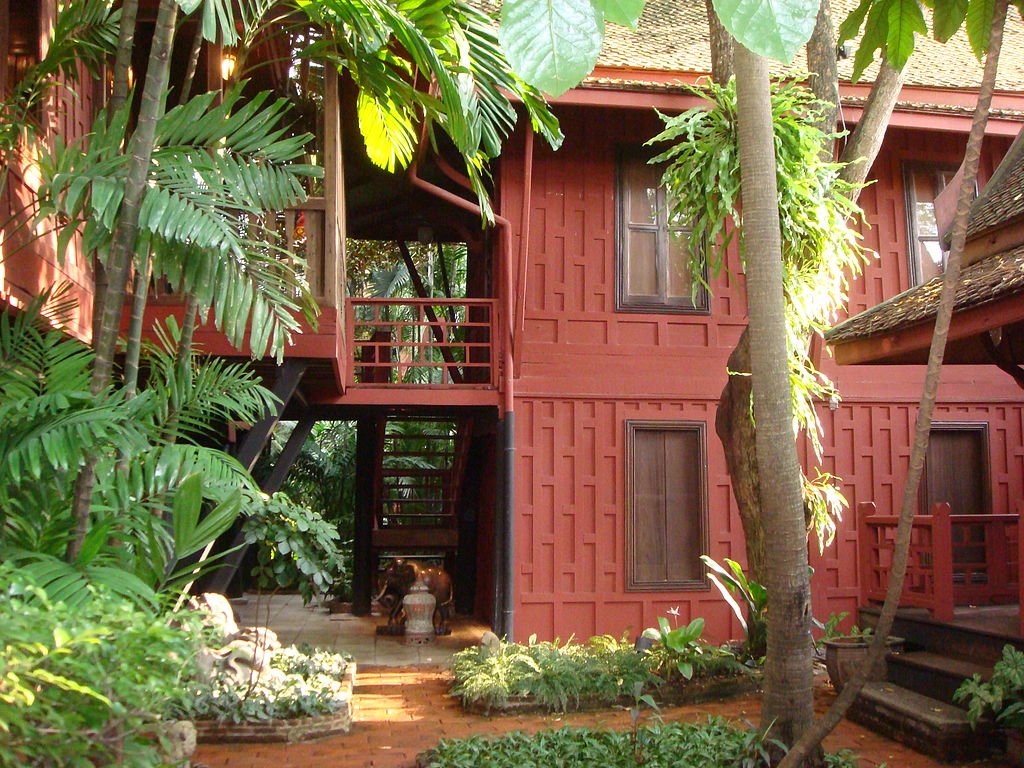
Art and design at the Jim Thompson House in Bangkok
The Jim Thompson House perfectly exemplifies how Thai traditions can coexist with modern architecture. The building is a unique example of Thai architecture incorporating Western elements such as glass windows, an Italian marble floor in the living room, and electric lamps like the impressive Belgian crystal chandelier.
One example of this blend is the carved wooden decorations on the windows, which traditionally face outwards. In Jim Thompson’s house, they are turned inwards, making the carved decorations visible. The living room windows have become niches to house the wooden statues of the four Burmese guardian spirits.
Every room in the house has been decorated with great attention to detail, with carefully selected furniture and textiles that combine traditional and contemporary styles. The result is a thoughtful and striking interior decoration, with beautiful paintings and carved wood carvings depicting ornamental motifs typical of Thai art.
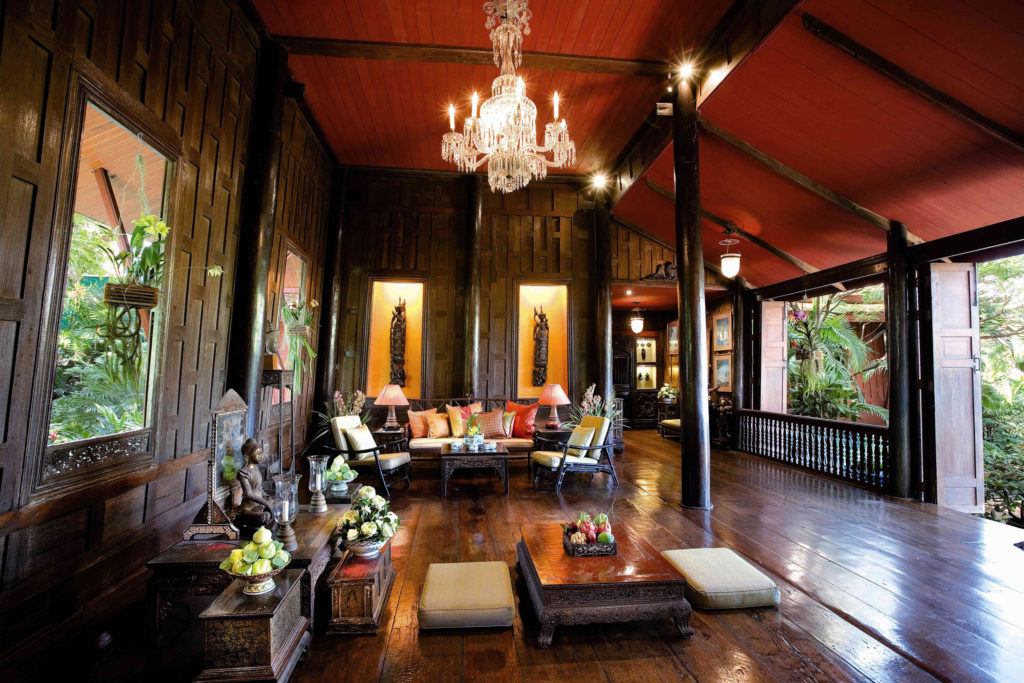
Art in Jim Thompson’s Thai home
Jim Thompson’s house in Bangkok is an excellent showcase of Southeast Asian art and craftsmanship. When he launched his silk trading business, Jim Thompson was particularly interested in Thai, Cambodian, Burmese, and Chinese art.
The dining room ceramics, statues, paintings, and even the more curious objects like the rat maze, which the Chinese used as a game of chance to bet on which rat would come out first, reflect a sophisticated taste and meticulous attention to detail.
After Jim Thompson died in mysterious circumstances in Malaysia, his house became a popular tourist attraction and a cultural centre, known as Jim Thompson Art Centre. The centre collaborates with local and international cultural institutions to organise temporary exhibitions, produce publications, and conduct educational programs.
The Jim Thompson House Garden
The meticulously designed Jim Thompson House garden is a delightful revelation awaiting your visit to the museum. Conceived by Jim Thompson himself, this space seamlessly integrates with the house, offering a genuine oasis of serenity amid the lively streets of Bangkok. A myriad of tropical plants surrounds a serene canal that gracefully opens into a picturesque pond, adding a touch of tranquillity to your cultural journey.
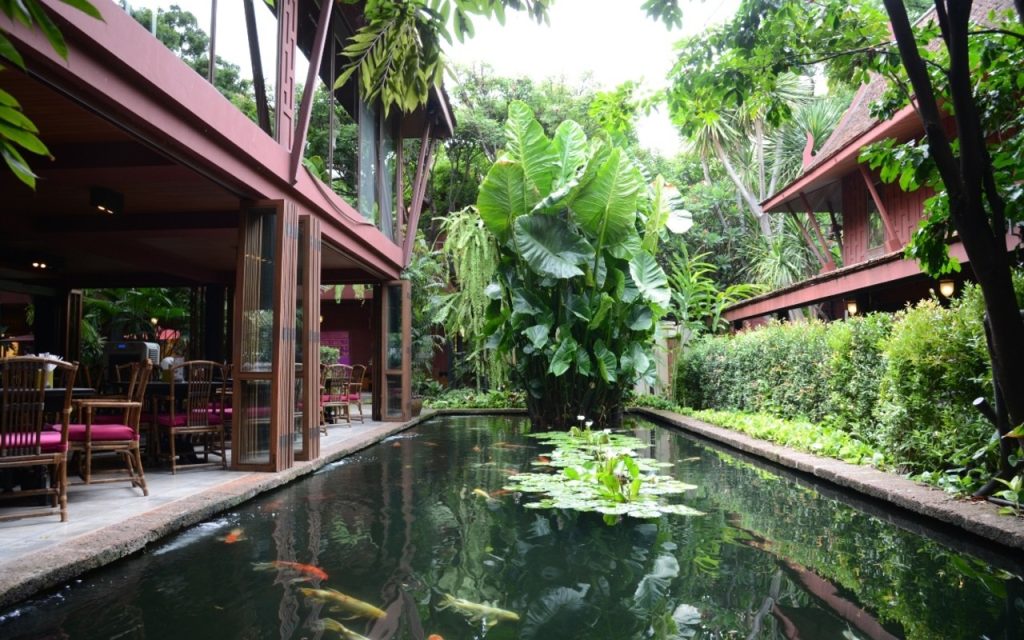
The adventurous life of Jim Thompson: from CIA agent to silk tycoon
Jim Thompson, the former owner of the Jim Thompson House in Bangkok, lived an adventurous and extraordinary life. He was born in Greenville, Delaware, in 1906 and was the youngest of five children in a family of textile manufacturers. After studying at Princeton, he pursued architecture at the University of Pennsylvania but didn’t complete his degree.
Later, he worked as a designer for Holden McLaughlin Associates in New York from 1931 to 1949. However, Thompson’s fascination for textiles led him to start producing costumes and fabrics for the Ballet Russe de Monte Carlo during the same period.
Jim Thompson’s arrival in Thailand
In 1941, Jim Thompson enlisted in the Delaware National Guard, which led him to Thailand. When the United States entered the war, he joined the Office of Strategic Services, a unit that later became the CIA.
Jim Thompson had several assignments in North Africa and Europe before he was sent to Sri Lanka in 1945 to prepare for the invasion of Thailand. However, he arrived in Thailand a couple of hours after the end of World War II, which aborted his mission before it could even begin.
Determined to stay in Thailand, Jim Thompson began work on renovating the Oriental Hotel. The hotel was where the military had remained during the conflict. However, the project was soon abandoned due to constant delays caused by investor disagreements. Subsequently, Jim Thompson devoted himself to trading and exporting Thai silk, which proved a huge success.
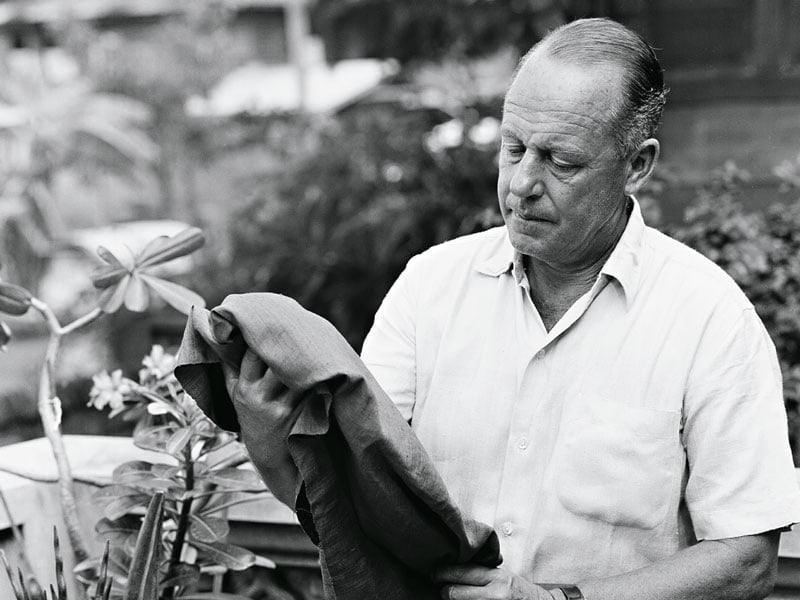
The beginning of the Thai silk adventure
After World War II, silk production in Thailand was limited, and there was no wholesale market. In 1947, Jim Thompson realised the commercial potential of Thai silk and started his first production in collaboration with a group of Muslim weavers from the Ban Krua community in Bangkok.
Thanks to his experiences in the fabric trade in his family and New York, he sent fabric samples to fashion houses in Milan, London and Paris, starting his business. During a trip to New York to find buyers, the silks woven by the Ban Krua weavers caught the attention of Edna Woolman Chase, the then editor of Vogue Magazine, who decreed their commercial success.
The commercial success of Thai silk
In 1948, the Thai Silk Company Limited was officially established and became one of the world’s largest producers and sellers of silk. Among the most prestigious buyers were Broadway producers and the Thai royal house. In 1950, he opened his first shop on Surawong Road, continuing his collaboration with local weavers in Ban Krua.
The fame of Jim Thompson’s textiles spread even further after the release of the Broadway production The King and I, the inspiration for the film Anna and the King starring Jodie Foster. The sumptuous costumes worn by Irene Sharaff were made from his silks.
Another great moment for Jim Thompson’s Thai silks was 1959 when the King and Queen of Thailand wore dresses made from his silks based on Pierre Balmain’s designs during their visit to the United States. Queen Sirikit then remained a loyal customer, and Jim Thomson produced gold brocaded silks for her exclusive use.
The mysterious death of Jim Thompson
Jim Thompson disappeared mysteriously during a holiday in the Cameron highlands of Malaysia in 1967. During a walk with friends, he wandered off and never returned. Despite a major search operation involving 400 men, no clues to his disappearance were found.
Meanwhile, Jim Thompson’s sister was violently murdered in the USA. This event started a series of conjectures and conspiracy theories concerning the involvement of the CIA or communist spies. There are various hypotheses about Thompson’s disappearance, from suicide to voluntary disappearance to a tiger attack. To find new leads for the investigation, 110 mediums were also approached, without success.
For further reading, I recommend William Warren’s book Jim Thompson: The Unsolved Mystery, which recounts the adventurous life and disappearance of Jim Thompson, still one of Thailand’s biggest mysteries. Jim Thompson’s disappearance continues to arouse curiosity and interest in the public to this day.
Jim Thompson’s legacy: business and foundation
After Jim Thompson’s death, the company he founded continued to expand. They opened flagship stores in various cities worldwide and became a significant silk exporter. Multiple contexts, such as the costumes for the film Ben Hur, the restoration of the Canaletto room at Windsor Castle and the decorations of the London Savoy Hotel, used Jim Thompson’s silk.
Jim Thompson’s house and possessions were transferred to the James H.W. Thompson Foundation, which manages Jim Thompson’s brand of museums, art centres, clothing and furniture shops, restaurants, and silk farms. In 1980, the Thai Silk Company moved its silk production to Pak Thong Chai, a village northwest of Thailand, to expand the craft space and increase silk production on an industrial scale. All the steps in creating the fabrics, from selecting the silk cocoon to the final weaving, still occur within the complex of about fifty buildings.
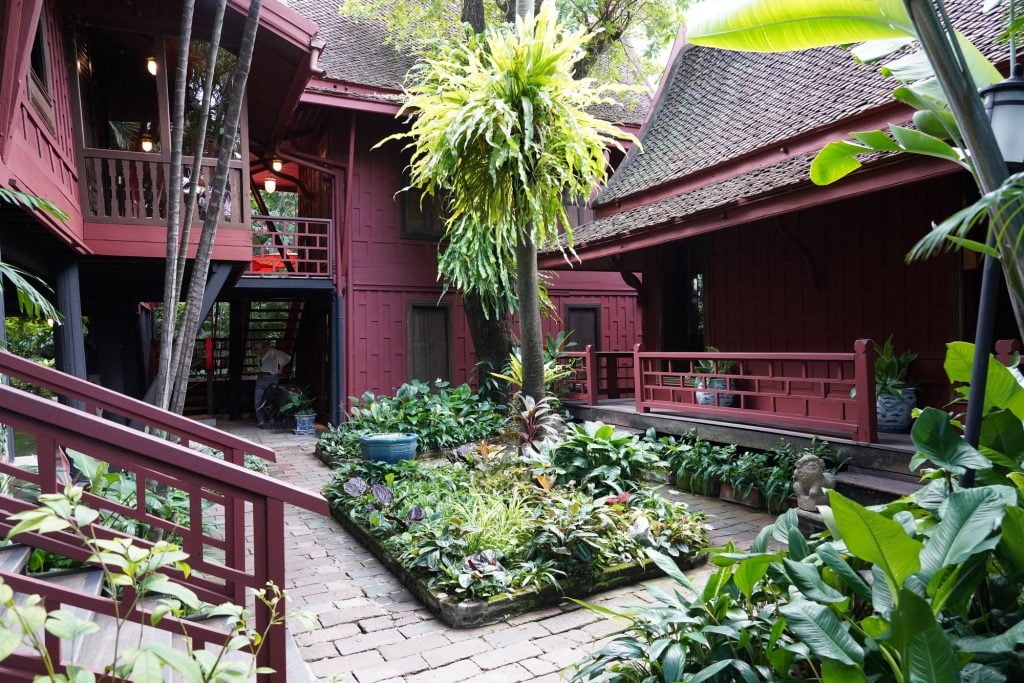
Practical information for visiting the Jim Thompson House
The Jim Thompson House in Bangkok is a fascinating place to visit. It is known for its beautiful architecture that blends Eastern and Western styles and the adventurous history of its owner. You are not allowed to take pictures inside the house, but you are free to roam around the beautiful garden and take pictures. The staff is meticulous about this rule, possibly because flash photography could damage the art objects.
Entrance fees and guided tours
To enter the Jim Thompson House, visitors must purchase tickets from the ticket office at the museum’s entrance. Jim Thompson House tickets cost 200 baht, just around €5 at the current exchange rate. Children under 10 can enter for free if accompanied by an adult.
Guided tours, included in the entrance fee, are the only way to visit the inside of the house. They leave at fixed times and are available in English or French. Tours provide a detailed overview of the history of the house and its collection of arts and crafts.
In addition, visitors can join a guided tour of the Jim Thompson House and the Baan Krua community, where Thai silk exported worldwide was first woven. Alternatively, they can opt for a tour of Jim Thompson House and Suan Pakkard Palace, the former home of Prince Paripatra. It is a museum displaying Thai antiques, including Ban Chiang pottery that is over 4000 years old.
Opening Hours
The Jim Thompson House is open daily from 10 am to 6 pm, with the last guided tour leaving one hour before closing. Despite being one of the busiest tourist spots in Bangkok, I’ve never had trouble buying tickets every time I’ve been back, but I’ve always turned up in the morning at opening time.
How to get to the Jim Thompson House
The Jim Thompson House is in the Pathumwan district of Bangkok. The fastest way to get there is via the BTS Sky Train, getting off at the National Stadium or Ratchathewi stop. Look at Google Maps for the best route from your hotel or starting point to choose the fastest route with fewer changes.
Alternatively, you can get to Jim Thompson House by taxi or tuk-tuk, another popular means of transport in Bangkok. Bear in mind, however, that due to the congested traffic in the Thai capital, it may take a long time to get there if you start from the other side of the city.
Jim Thompson House
6 Soi Kasemsan 2
Rama 1 Road, Bangkok
Where to stay in Bangkok
I have visited Bangkok many times and have stayed in various hotels across different price ranges. Based on my experience, I recommend some of the best establishments I have stayed in.
The most luxurious hotel is the Mandarin Oriental Bangkok, featuring an outdoor pool, world-class service, and a restaurant that serves Chinese, French, and Italian cuisine. In the Chinatown district, the stylish Shanghai Mansion Bangkok hotel, inspired by 1930s Shanghai, has one of the best Chinese restaurants in the city.
If you are looking for more affordable accommodation, avoid Khao San Road, which is very touristy and mainly offers spartan dormitory beds. Instead, you can choose a boutique hostel in some historic buildings. I recommend 1905 Heritage Corner, a colonial-style shophouse converted into a hotel. Mojo Old Town Phranakorn and Niras Bankoc Hostel are also great options for private rooms and simple in-house lunch and breakfast restaurants.
I highly recommend visiting the Jim Thompson House if you’re in Bangkok. It’s a unique experience that allows you to appreciate traditional Thai architecture and design, as well as learn about the fascinating life of Jim Thompson. He was an adventurous entrepreneur and former CIA agent who revived the ancient art of Thai silk and promoted it to the world. Please comment if you have visited the Jim Thompson House before and what you liked about this unique experience.
